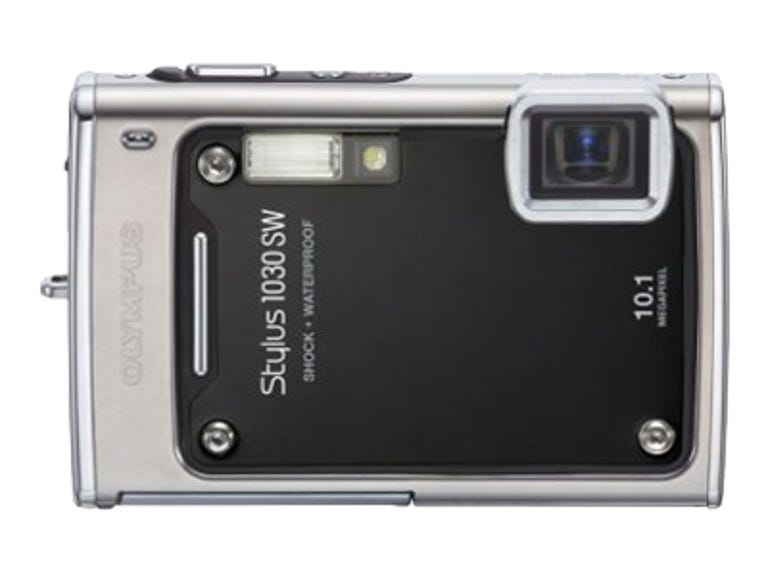 Why You Can Trust CNET
Why You Can Trust CNET Olympus Stylus 1030 SW review: Olympus Stylus 1030 SW
Olympus Stylus 1030 SW
Olympus has some of the roughest and toughest cameras on the market, most notably the 10-megapixel Stylus 1030 SW, a compact, point-and-shoot camera that's rugged enough to outlast any contestant on Survivor. But you don't have to be exiled or an adventurer to take advantage of the camera's waterproof, shockproof, freezeproof, and crushproof specifications.
The Good
The Bad
The Bottom Line
Although the 1050 SW is newer than the 1030 SW, don't let the numerical sequence fool you. The 1030 SW succeeds the 790 SW while the not-quite-as-tough 1050 SW replaces the 770 SW. What you really need to know is that the 1050 doesn't match up to the 1030's capability to withstand pretty much anything you can throw at it (or throw it at). While the 1050 SW is shockproof to 5 feet, waterproof to 10 feet and freezeproof to 14 degrees Fahrenheit, the 1030 SW beats on all counts and adds a few extras. You can drop the latter from a height of 6.6 feet, take it underwater to a depth of 33 feet, haul it out in 14-degree weather and attempt to crush it with up to 220 pounds of pressure. A 3.6x wide-angle zoom lens with a 35mm-equivalent focal range of 28mm-102mm also sets it apart from its siblings.
You only have to look at--and hold--the metal-bodied 1030 SW to start believing that this compact camera is rugged enough to withstand everything Olympus promises. At the same time, the camera is attractively designed; at 3.7 inches by 2.4 inches by 0.8 inch and 6.8 ounces fully loaded, it's compact enough to carry in your pocket while you're hiking up the side of a mountain or around your wrist while diving a shipwreck or a garden of coral and pretty fish.
Scuba divers should note that underwater time is limited to one hour. If you want to take the camera deeper or on an extended dive, check out Olympus' underwater housing for the 1030 SW. Also, anyone using the camera under, on or near the water should be aware that the camera is not buoyant--if you let go, the camera's going to sink.
But you don't have to participate in extreme sports to benefit from the camera's tightly sealed seams. Gaskets and O-rings, as long as you maintain them, will keep out water, snow, sand, dirt and other assorted tiny debris that would wreak havoc with more vulnerable digital cameras.
Like most snapshot cameras, the 1030 SW lacks an optical viewfinder. But its 2.7-inch, 230K-dot LCD features a wide angle of view and, with its five-step brightness adjustment, can be tweaked to work reasonably well under most conditions. If you're diving in dark environments--East Coast shipwrecks come to mind--you may have some problems viewing the display. But midsummer swimming pool conditions with bright sunlight overhead improves the LCD's underwater usability.
Given the camera's physical dimensions and the LCD's size, the controls are pretty small and tightly grouped. If you have large hands, try the camera before you buy it (which we recommend for all camera purchases). More important, even though the camera can handle subfreezing temperatures, you may not be able to handle the 1030 SW while wearing heavy gloves. It's going to be interesting to see how well the 1050 SW's new TAP control interface works since that might be a good option for the 1030 SW's successor.
On the plus side, the 1030 provides easy access to settings through its dedicated controls and function button, a good thing since I've never been crazy about Olympus' virtual menu system. Since the 1030 SW is strictly point-and-shoot, you probably won't be fiddling with too many adjustments, but when you do, the function button will provide quick and easy access to settings you're most likely to change: white balance, ISO, drive mode, metering, and image quality.
The 1030 SW offers the requisite Auto, Program AE, and Movie modes along with a variety of scene modes, including special underwater options. However, the camera is tricked out with a couple of cool features. Live preview allows you to see how different settings--white balance, for example--will affect the photo you're about to shoot. And beginners will appreciate the 1030 SW's onboard Guide. Just choose from one of more than a dozen shooting situations or tasks (such as backlight or brightening a subject) and the Guide will offer options and automatically set the camera for whatever selection you make. It's a good learning tool, too.
Although performance is improved over the 790SW, speed isn't one of the 1030 SW's big selling points. Although start-up time is a respectable 1 second, it takes close to two seconds between shots without flash and more than double that with the flash. At only 0.8 second, the burst mode won't keep up with action. But autofocus is fairly responsive and its shot lag of 0.5 second under optimal conditions and 0.6 second in dim, is minimal.

While colors reproduce accurately, the camera's bright exposures can sometimes make them look a bit washed out. Although test shots show good detail, the photos tend to be soft. In fact, the 1030 SW isn't going to score many points for sharp focus. Overall, the photos look pretty pleasing, though.
Let's face it; other cameras will deliver better image quality, a broader feature set, and faster performance at the same price or less. But you're not going to find another camera that's as tough as the Olympus Stylus 1030 SW.
(Shorter bars indicate better performance)
| Time to first shot | Flash shot-to-shot time | Typical shot-to-shot time | Shutter lag (dim light) | Shutter lag (typical) |
(Longer bars indicate better performance)
